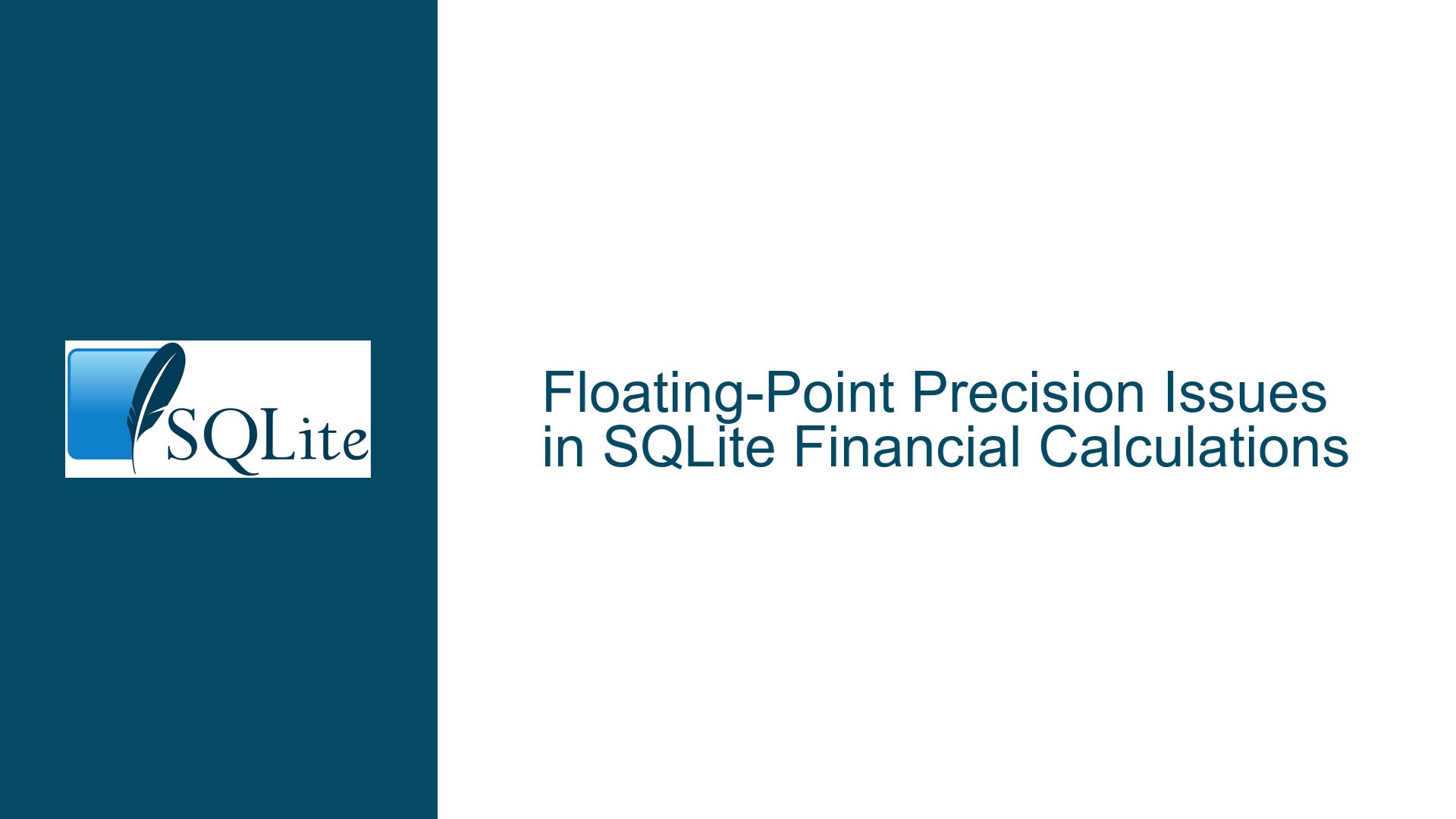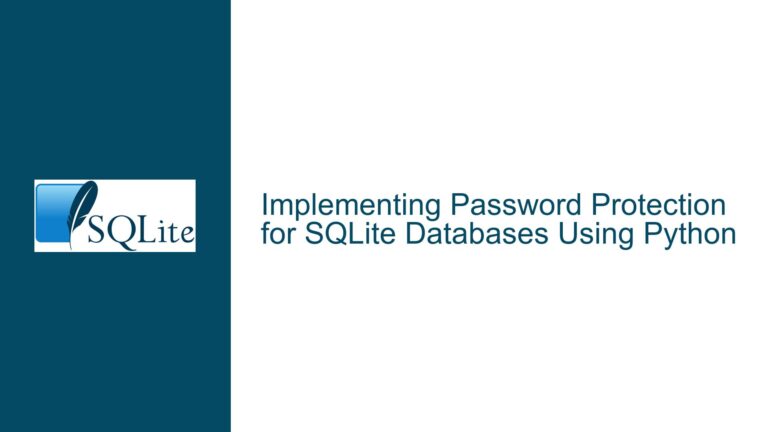Floating-Point Precision Issues in SQLite Financial Calculations
Understanding Floating-Point Arithmetic and Its Impact on Financial Calculations
Floating-point arithmetic is a fundamental concept in computer science, but it is often misunderstood, especially when applied to financial calculations. The core issue arises from the inherent limitations of binary floating-point representation, which cannot precisely represent certain decimal numbers. This limitation is not unique to SQLite but is a characteristic of how floating-point numbers are handled in virtually all programming languages and databases that rely on the IEEE 754 standard.
In the context of SQLite, the problem manifests when performing operations on decimal numbers, such as summing monetary values. For example, the decimal number 16.15 cannot be represented exactly in binary floating-point. Instead, it is stored as a close approximation, such as 16.149999999999998578914528. When this approximation is multiplied by 100, the result is 1614.9999999999997726263245, which, when cast to an integer, truncates to 1614 instead of the expected 1615.
This behavior is consistent with the IEEE 754 standard, which defines how floating-point numbers are represented and manipulated in binary. The standard provides a compromise between range and precision, allowing for a wide range of values but at the cost of exact representation for certain decimal numbers. This trade-off is generally acceptable for scientific and engineering applications but can lead to significant issues in financial calculations, where precision is paramount.
The discrepancy observed in SQLite is not a bug but a consequence of adhering to the IEEE 754 standard. Other databases, such as MariaDB, may appear to handle these calculations differently, but this is often due to additional rounding steps or internal adjustments that are not part of the standard. These differences can lead to inconsistent results across different platforms, further complicating the issue.
The Role of Data Types and Affinity in SQLite
SQLite’s handling of data types is another critical factor in understanding the precision issues. Unlike many other databases, SQLite uses a dynamic type system, where the type of a value is associated with the value itself rather than the column in which it is stored. This system allows for greater flexibility but also introduces potential pitfalls, especially when dealing with numeric data.
In SQLite, the NUMERIC and DECIMAL types are treated as floating-point numbers, not as fixed-point decimals. This means that even if you explicitly cast a value to NUMERIC or DECIMAL, it will still be stored and manipulated as a floating-point number. This behavior is by design, as SQLite aims to be lightweight and relies on the underlying C library’s floating-point functionality.
The dynamic type system also means that SQLite does not enforce strict type checking. For example, you can insert a text string into a column with INTEGER affinity, and SQLite will attempt to convert it to an integer. This flexibility can be both a blessing and a curse, as it allows for rapid prototyping but can also lead to subtle bugs if not managed carefully.
In the context of financial calculations, the lack of true decimal types in SQLite can be a significant limitation. While other databases, such as PostgreSQL, offer native support for decimal arithmetic, SQLite requires additional steps to achieve similar precision. This limitation is part of the trade-off that comes with SQLite’s lightweight design, but it can be mitigated with the right approach.
Solutions and Best Practices for Handling Financial Data in SQLite
Given the limitations of floating-point arithmetic in SQLite, there are several strategies you can employ to ensure accurate financial calculations. The most straightforward approach is to avoid floating-point numbers altogether and use integers to represent monetary values. This method, known as fixed-point arithmetic, involves storing values as the smallest unit of currency (e.g., cents for dollars) and performing all calculations in this unit.
For example, instead of storing $16.15 as a floating-point number, you would store it as 1615 cents. This approach eliminates the precision issues associated with floating-point arithmetic, as all operations are performed on integers, which can be represented exactly in binary. When displaying the value to the user, you can convert it back to the appropriate currency format.
Another approach is to use SQLite’s ROUND function to explicitly round the results of floating-point calculations. This method can help mitigate the effects of floating-point imprecision but requires careful handling to ensure consistent results. For example, you can use the following query to round the result of a floating-point calculation to the nearest integer:
SELECT ROUND(SUM(CAST('16.15' AS NUMERIC)) * 100, 0);
This query will return 1615, as expected, by rounding the result of the floating-point calculation to the nearest integer. However, this approach still relies on floating-point arithmetic, so it is not a complete solution to the precision issue.
For more robust decimal arithmetic, you can use SQLite’s decimal extension or a third-party extension such as LifePillar’s decimal extension. These extensions provide true decimal arithmetic, allowing you to perform calculations with the precision required for financial applications. For example, you can use the following query with the decimal extension to multiply 16.15 by 100:
SELECT decimal_mul('16.15', '100');
This query will return 1615, as expected, without any loss of precision. The decimal extension achieves this by storing and manipulating numbers as strings, avoiding the limitations of binary floating-point representation.
In addition to these technical solutions, it is essential to adopt best practices for handling financial data in SQLite. These practices include:
Use Integer Types for Monetary Values: Store monetary values as integers representing the smallest unit of currency (e.g., cents). This approach eliminates the precision issues associated with floating-point arithmetic and ensures that all calculations are performed with exact precision.
Avoid Implicit Type Conversions: Be explicit about data types in your queries to avoid unexpected type conversions. For example, always cast text strings to the appropriate numeric type before performing calculations.
Use Decimal Extensions for Complex Calculations: For applications that require complex decimal arithmetic, consider using SQLite’s decimal extension or a third-party extension. These extensions provide the precision required for financial calculations and can help avoid the pitfalls of floating-point arithmetic.
Test Thoroughly: Financial applications require a high degree of accuracy, so it is essential to test your queries and calculations thoroughly. Pay particular attention to edge cases, such as very large or very small values, to ensure that your application handles them correctly.
Document Your Approach: Clearly document your approach to handling financial data in SQLite, including any assumptions or limitations. This documentation will help ensure that your application remains maintainable and that other developers understand the rationale behind your design decisions.
By following these best practices and leveraging the appropriate tools and techniques, you can overcome the limitations of floating-point arithmetic in SQLite and build robust, accurate financial applications. While SQLite may not offer the same level of support for decimal arithmetic as some other databases, its flexibility and extensibility make it a viable option for many use cases, provided that you take the necessary precautions to ensure precision and accuracy.






